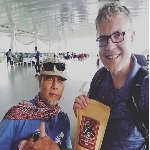Testimonials By Rudianto Sembiring
Gerog Gandenberger

Orangutans in Gunung Leuser National Park
On Tuesday I was picked up by my new guide Rudi (his name was actually Rudianto, but he shortened it to a German name to make it easier for me) for my hiking tour in the Gunung Leuser National Park. The drive to the park took about 2.5 hours in unusually light traffic because of the Chinese New Year public holiday. Once outside of the city we drove through nothing but palm oil plantations for miles and miles. This was the first time I had ever experienced the sheer scale of these plantations. And there were large trucks everywhere filled to the rim with palm nuts being taken to a nearby processing plant.
When we arrived at the park, Rudi handed me over to a local guide. Before we entered the park itself we walked through a rubber tree plantation. It was interesting to see how the rubber is collected by slicing the bark in a spiral and attaching a coconut shell at the bottom to collect the white rubbery sap.
Gunung Leuser National Park, established in 1980, received UNESCO World Heritage designation in 2004 as part of the WH site "Tropical Rainforest Heritage of Sumatra". The park covers a mountainous area of dense tropical rain forests of almost 8,000 square kilometers and straddles the border of the Aceh and North Sumatra provinces. It is one of the last habitats for Sumatran Elephants, Sumatran Tigers and the extremely rare Sumatran Rhinoceros, but all of these are near impossible to see. The reason I came here was the fact that the park is also home to the Sumatran Orangutan. I had never seen Orangutans in the wild before, and was told there is about a 75% chance of seeing them here. I was very excited about this and I would have been happy seeing even one of them from a distance, but what happened over the next two hours exceeded even my wildest expectations.
It took us only about 30 minutes before we came across the first group of these giant apes. We first saw a male sitting in the tree right in front of us. After watching him for a while build a nest (they move all the time and build a new nest to sleep in every day), we walked a bit further and suddenly saw a group of several females, two of which had tiny babies clinging to their thick fur. They were really close and I was able to get lots of incredible pictures.
Medan
The next morning Rudi picked me up from the hotel again for a half-day sightseeing tour through Medan. Medan is the capital of the North Sumatra province and the fourth largest city in Indonesia with a population of about 2.5 million. It was founded in the late 16th century and was part of the Aru Kingdom, which ruled this area form the 13th to 16th century.
Medan itself is not a major tourist destination, but it does have a few interesting and historical sights. Our first stop was the Graha Maria Annai Velangkanni catholic church, which was one of the weirder looking churches I have seen. It was built in the style of an Indian Mogul temple. It's also the only catholic church I have been to, where you have to take off your shoes before entering.
The Great Mosque of Medan, a beautiful white building constructed in 1906, was out final stop. We were there during the afternoon prayer, so I wasn't able to take a look inside.
Rudi dropped me off at the airport at 2:00 pm for my afternoon flight back to Singapore.
Final Note:
My guide, Rudianto Sembiring, was great. He also runs a rehabilitation center for rare species that were rescued from villages where they were kept as pets. His main focus is on the slow lori, which is a small and rare primate. You can support the rehabilitation center via this link, and if you need a guide in and around Medan, please e-mail me for Rudi's contact details.
This Testimonial is same that I was write on my Blog here : http://www.ggtravelblog.com/p/medan.html?fbclid=IwAR1b72Uq9lFI1l71nSlQFo9eh30d-tR8wkL-9aV5xX8I6N0Lm6HlOx5UC1g


